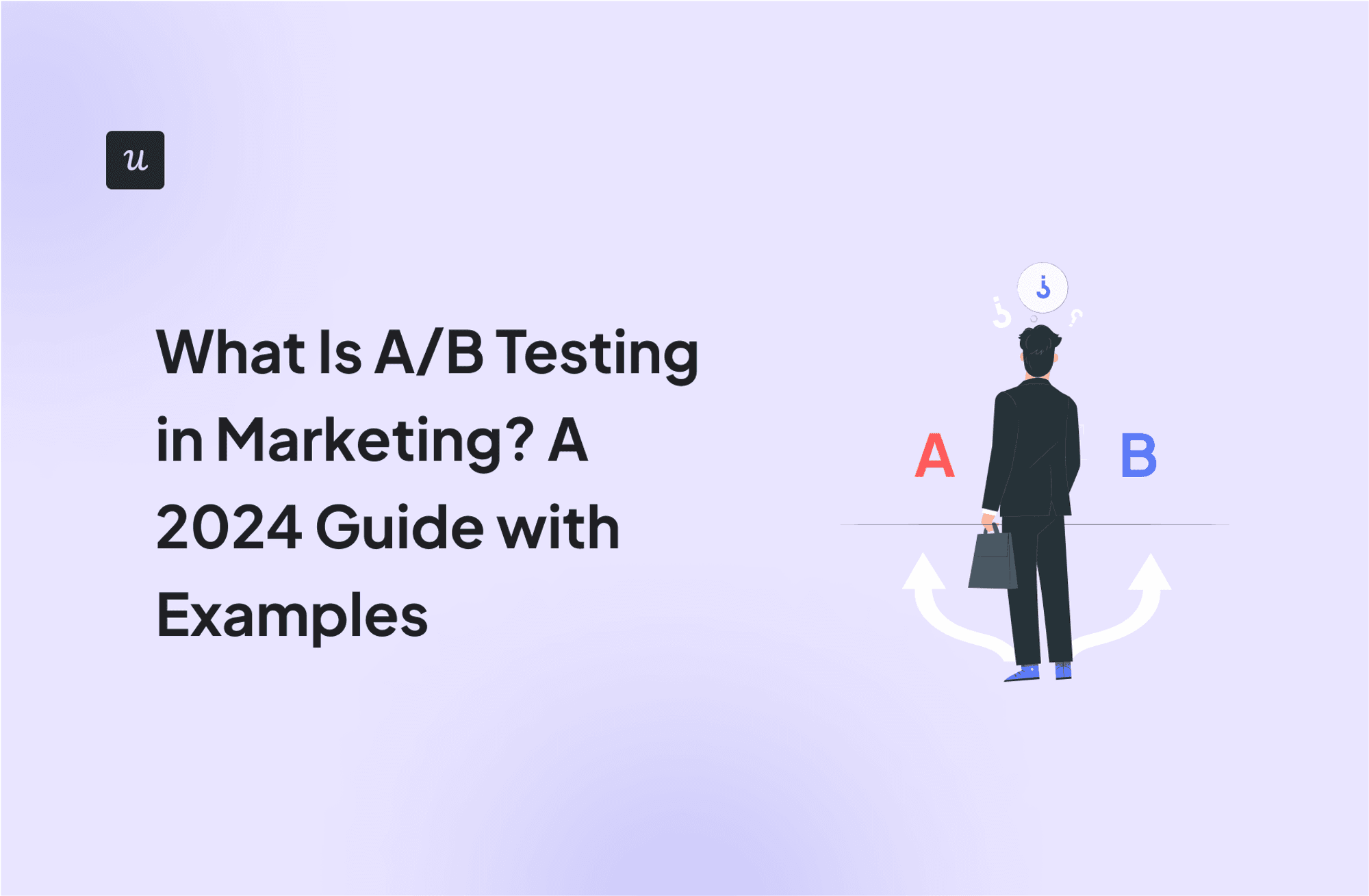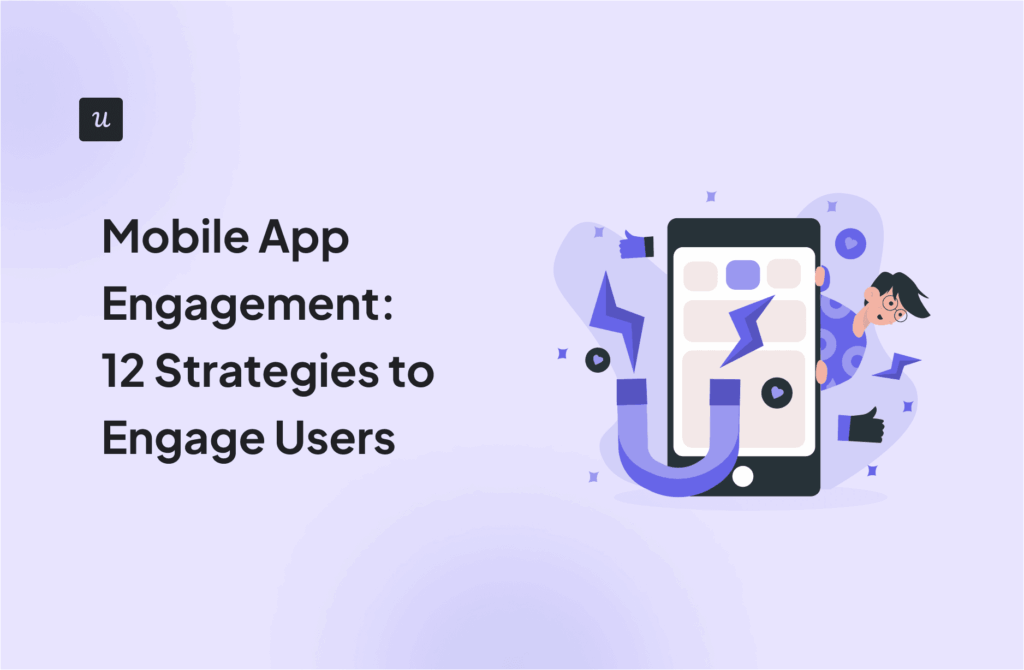
A/B testing is a powerful tool that can help you uncover hidden opportunities and optimize your marketing efforts.
Whether you’re looking to attract new leads or improve engagement with existing customers, this article will guide you through the A/B testing process from start to finish.
We’ll cover:
- What A/B testing means.
- Different types of A/B tests to implement.
- How to use the results of your A/B tests to make data-driven decisions that improve your marketing results.
What is A/B testing primarily used for in marketing?
For a simple, effective A/B test, how many variables should you change at a time?
Which testing method allows you to test multiple variables on a single page simultaneously?
You’ve got the basics down! Ready to stop guessing?
A/B testing eliminates guesswork and helps you make data-driven decisions to improve conversions. See how Userpilot makes it easy.
Try Userpilot Now
See Why 1,000+ Teams Choose Userpilot

What is A/B testing?
A/B testing, also known as split testing, is a method of comparing two versions of a landing page, subject line, or another marketing asset to determine which one performs better.
You can also experiment with different customer segments, different messaging strategies, and more.
It’s crucial for marketing because it enables teams to make data-driven decisions and optimize marketing efforts easily.
By systematically testing different variations, you can identify what assets and messages resonate best with your audience. All this leads to improved conversion rates, higher customer satisfaction, and more effective use of marketing resources.
Benefits of A/B testing
A/B testing offers numerous advantages that can significantly enhance your marketing campaigns. Here are some of the main benefits:
- Enhanced user experience: The process helps you identify which version offers a better user experience, leading to increased satisfaction and higher conversion rates.
- Data-driven decision making: A/B testing eliminates guesswork. It empowers you to make informed decisions based on real user behavior and preferences.
- Customer-centric approach: A/B tests focus on understanding what your customers truly want, leading to more personalized and relevant experiences that drive engagement and loyalty.
How does A/B testing work?
As earlier mentioned, A/B tests compare two versions of the same thing to see what resonates best with the audience. Here’s how it works in a nutshell:
- Create two versions: Develop two different versions of one piece of content, changing only a single element (e.g., headline, button color, or image).
- Split the audience: Show these versions to two similarly-sized audiences, ensuring the groups are statistically similar.
- Analyze performance: Measure each version’s performance over a set period long enough to gather meaningful data.
A/B testing example
Let’s consider an example. Imagine you want to determine if changing the text of a call-to-action (CTA) button to the top of a web page will improve its click-through rate (CTR).
The setup will look like this:
- Control (Version A): “Get started”
- Variation (Version B): “Try it for free”
Execution:
- Split your website visitors into two equal groups.
- Show version A to one group and version B to the other.
Outcome:
- Measure the click-through rates for both versions.
- Determine if the new CTA placement (Version B) performs better (the one with the higher click-through rate wins).

Fictional A/B test result.
What can you A/B test in marketing?
A/B testing can be applied across various areas of marketing, from advertisements to websites, product experiences, SEO, and more. Here are some examples:
- Headlines and subheadings: Experiment with different wording, lengths, and styles to see which one captures the most attention and encourages clicks.
- CTA buttons: Test various colors, placements, sizes, and text to discover what motivates users to take action.
- Forms: Simplify forms by testing different field lengths, layouts, and required fields to reduce friction and increase conversions.
- Navigation menus: Optimize your website’s navigation by testing various structures, labels, and placements to improve user experience.
- Product descriptions: Evaluate several descriptions to determine which provides clearer information and persuades more customers to make a purchase.
- Subject lines: Try different email subject lines to find out which one results in higher open rates and engagement.
- Personalization: Compare personalized content against generic content to measure the impact on user engagement and satisfaction.
- Ad copy and visuals: Experiment with different ad texts and images to see which combination attracts more clicks and conversions.
- Targeting options: Experiment with various psychographics, interests, and behaviors to reach the most relevant audience for your ads.
- Landing pages: Test headlines, layouts, images, and CTAs to optimize your landing pages for conversions.
- Content formats: Experiment with different types of content, such as blog posts, videos, infographics, and podcasts, to see what engages your audience the most.
- Pricing models: Compare pricing models to see which one leads to higher sales and customer satisfaction.
- User onboarding: Experiment with various onboarding processes to determine which one helps users understand and engage with your product more effectively.

The key types of A/B tests
There are three main types of A/B tests: split testing, head-to-head tests, and multivariate testing. Let’s discuss them so you understand which works best for your context:

Split URL testing
Split URL testing involves creating entirely separate web pages with distinct URLs and randomly assigning web visitors to either the original page or one of the variations.
This testing method is ideal when you want to compare drastically different page designs or layouts. For example, if you’re considering a major website redesign, split URL testing can help you determine which design resonates better with your audience before fully committing.
Redirect tests (head-to-head A/B tests)
As the name suggests, redirect tests divide website traffic between two completely different URLs. Unlike a split test, this method allows visitors to land on the original page before seamlessly redirecting a portion of the traffic to a variation hosted on a different URL.
The choice between redirect tests and split URL tests depends more on the technical setup and desired level of control rather than the extent of the changes being tested. Both methods can be used for a variety of test scenarios, from minor tweaks to major overhauls.
Multivariate testing
Multivariate testing involves testing multiple variables on a single page simultaneously. For example, you might test different combinations of headlines, images, and CTAs for your landing page. This allows you to see how various elements interact with each other and identify the most effective combination.
MVT is best suited for pages with high traffic, as it requires a large sample size to achieve statistically significant results.
Multivariate testing vs A/B testing
Multivariate testing shares the same philosophy and mechanism as A/B tests. The difference is that multivariate tests allow you to compare multiple elements at a time.
Traditional A/B testing is simpler than multivariate tests, so the latter is best suited for advanced testers—you might get confused by the results if you don’t know your way around it.
When to conduct A/B testing
A/B testing isn’t a one-time event; it’s an ongoing process that helps you continuously improve and refine your strategies.
However, there are specific scenarios where testing is particularly valuable:
- New campaigns or product launches.
- When you notice a decline in performance.
- Regular optimization as part of your marketing SOPs (decide on the intervals based on your internal processes).
How to perform an A/B test
Follow these simple steps:
1. Identify goals and hypotheses
Start by clearly defining what you want to achieve with the A/B test.
What specific metrics are you trying to improve (e.g., click-through rates, web page conversion, in-app engagement)?
Then, formulate a hypothesis about how changing a particular variable will impact those metrics. You can use this formula:
“Changing (element you are testing) from _____ to _____ will increase/decrease (a metric).”
Example: Changing the CTA button color will increase clicks.
2. Select variables to test
Choose the specific elements or variables you want to test. Focus on one variable at a time to isolate its impact and avoid confusing results.
While selecting your variables, aim to identify any external factors that might influence the test results (e.g., seasonality or ongoing promotions).
Ensure these factors are consistent across both the control and variation during the test period.

3. Create variations
Now is the time to create your test variations. You only need two for a standard A/B test:
Design version A (Control)
Use the existing version of the element as the control. Before proceeding, ensure it accurately represents the current user experience.
Design version B (Variation)
Create the variation based on your hypothesis, ensuring the only difference between the control and the variation is the variable being tested.
For instance, if you’re experimenting with your CTA color, that should be the only difference between both versions.

4. Define your sample and split your audience
Determine the size of your sample and ensure it is representative of your overall audience.
To avoid bias, split this sample randomly into control and variation groups.

Most A/B testing tools like Userpilot allow you to calculate the sample size needed for statistical significance. Alternatively, you can use free online calculators.
5. Implement the test and track the results
Use A/B testing tools to implement the test and collect data in real time.
Continuously track the performance of both versions and make decisions based on the test results.

How to measure and interpret A/B testing results
A/B testing is only the beginning. The real value lies in analyzing the results and implementing changes that drive improvement. This section shows you how.
1. Collect the data
Gather data from the A/B testing or analytics platform you’re using.
Don’t rush the results; wait until you have sufficient data to draw reliable conclusions. Most A/B testing tools have built-in calculators or features to help you determine statistical significance.
2. Make a decision and implement changes
Compare the performance of each variation based on your chosen metrics. The variation with the better results (e.g., higher conversion rate) is your winner.
If the results are inconclusive or you can’t meet your goals, consider refining your hypothesis and trying again.

3. Report and document your findings
Write a detailed report of the testing process, from hypothesis to results.
Highlight the winning variation, the impact on your key metrics, and any relevant insights or learnings.
This is important because you can use the document to inform future tests and marketing strategies.
Examples of A/B marketing tests
Here are some hypothetical A/B test examples to inspire your next experiment:
Example 1: In-app banner test
Scenario: Optimizing an in-app product banner for engagement.
Objective: Increase the CTR of in-app banners in a web application.
Hypothesis: Testing different banner copy will result in varying levels of user engagement.
Setup:

- Control (Version A): “Scale your ads! Create images 5x faster and cheaper with our new AI image generator.”
- Variation (Version B): “Ran out of creative ideas? Generate high-quality ad visuals with our new AI image feature.”
Execution:
- Design: Create two versions of the in-app banner with different copy but identical designs and placements.
- Audience split: Randomly split the app users into two groups, ensuring an equal number of users see each version.
- Tracking: Use in-app analytics tools to track the number of clicks on the banners in both versions.
Results:
- Control (Version A): 200 out of 5,000 users clicked the banner (4% CTR).
- Variation (Version B): 350 out of 5,000 users clicked the banner (7% CTR).
Conclusion: Using the copy “Ran out of creative ideas? Generate high-quality ad visuals with our new AI image feature” increased the CTR by 75%. Implementing this change can significantly enhance user engagement with in-app promotions.
Example 2: Ad campaign test
Scenario: Testing Ad copy.
Objective: Increase the CTR of a Google Ads campaign.
Hypothesis: Including a special offer in the ad copy will result in a higher CTR compared to a standard ad copy featuring free shipping.
Setup:

- Control (Version A): Buy Quality Running Shoes Online – Free Shipping.
- Variation (Version B): Buy Quality Running Shoes Online – 20% Off Today Only.
Execution:
- Design: Create two versions of the ad with the different copy versions.
- Audience Split: Use Google Ads to randomly show the two ad versions to the target audience.
- Tracking: Monitor the CTR for both ad versions using Google Ads analytics.
Results:
- Control (Version A): 1,500 clicks out of 50,000 impressions (3% CTR).
- Variation (Version B): 2,500 clicks out of 50,000 impressions (5% CTR).
Conclusion: Including a special offer in the ad copy increased the CTR by 67%. Implementing this change can drive more traffic to the website and potentially increase sales.
Tips for effective A/B testing
Finally, make sure to follow these simple results to achieve the best results with your A/B experiments:
- Always focus on your goals.
- Test one variable at a time.
- Always test both versions simultaneously.
- Run A/B tests for an adequate duration.
- Document everything.
- Ensure there are no external influences.
- Make sure the results are statistically significant.
Conclusion
A/B testing is an efficient way to better understand your audience and eliminate the guesswork in conversion rate optimization.
The best part: it doesn’t interrupt the user experience, as users wouldn’t even know you’re conducting an experiment.
Ready to roll out your first or next product experiment?
Userpilot can help. Book a demo to see how you can use our platform to create test variations, segment users, analyze test results, and implement changes easily.








